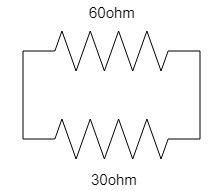Question
Question: You have two resistors of resistance \(30\Omega \) and \(60\Omega \). What resistances can you get b...
You have two resistors of resistance 30Ω and 60Ω. What resistances can you get by combining the two?
Solution
Firstly, we will connect the resistances in a series combination and calculate the equivalent resistance in this case. Then we will connect the two resistances in a parallel combination and then again we will calculate the equivalent resistance of these two resistors.
Complete step by step solution:
The two basic ways to connect any two resistances are, parallel combination and series combination. In a series combination the starting point of a resistor is the ending point of any other resistor. Whereas in a parallel combination, all the resistances have the same starting point and the ending point.
On connecting the two resistances in series,

Rs=R1+R2
On putting the value of the two resistors, we get,
Rs=60+30
Rs=90Ω......(1)
So, if we connect the two resistances in a series combination, then the value of the equivalent resistance is Rs=90Ω.
Similarly, if we connect the two resistances in a parallel combination, then,

Since, the two resistances are in a parallel combination, so,
Rp1=R11+R21
On putting the values of the two resistances, we get,
Rp1=601+301
Now, we will take the LCM,
Rp1=601+2
Rp1=603
On taking the reciprocal on both the sides, we get,
Rp=360
Rp=20Ω.......(2)
So, if we connect the two resistances in a parallel combination, then the value of the equivalent resistance is Rp=20Ω.
So, on connecting the two resistances in series combination, we get the equivalent resistance as Rs=90Ω. On connecting the resistances in parallel, we get the equivalent resistance as Rp=20Ω.
Note:
When two or more resistances are connected in a series combination, then the current flowing through all of them is the same but the potential difference of each of them is different. On the other hand, when two or more resistances are connected in a parallel combination, then the potential difference across each of them is the same but the current in each of them is different.
